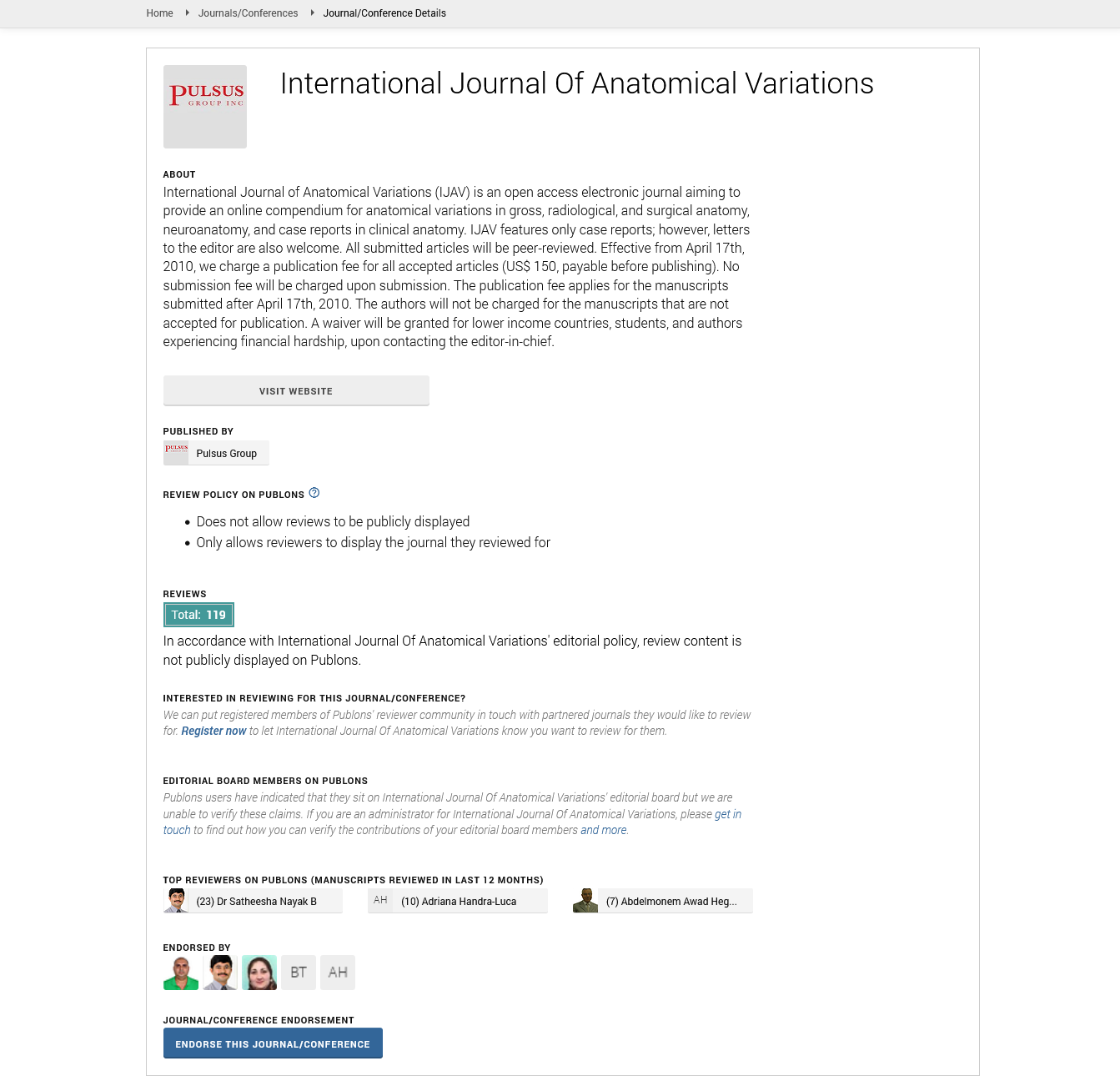Variations in the Morphology of the Psoas Minor Muscle: A Comprehensive Review of Anatomical and Clinical Implications
Received: 01-Nov-2024, Manuscript No. ijav-24-7334; Editor assigned: 04-Nov-2024, Pre QC No. ijav-24-7334 (PQ); Reviewed: 18-Nov-2024 QC No. ijav-24-7334; Revised: 25-Nov-2024, Manuscript No. ijav-24-7334 (R); Published: 30-Nov-2024, DOI: 10.37532/1308-4038.17(11).456
Citation: Zhang Y. Variations in the Morphology of the Psoas Minor Muscle a Comprehensive Review of Anatomical and Clinical Implications. Int J Anat Var. 2024;17(11): 681-682.
This open-access article is distributed under the terms of the Creative Commons Attribution Non-Commercial License (CC BY-NC) (http://creativecommons.org/licenses/by-nc/4.0/), which permits reuse, distribution and reproduction of the article, provided that the original work is properly cited and the reuse is restricted to noncommercial purposes. For commercial reuse, contact reprints@pulsus.com
Abstract
The psoas minor muscle, although present in only about 40-50% of the population, plays a minor role in lumbar spine function. However, its variations in morphology and anatomical presentation can have significant clinical implications. This research article explores the variations in the morphology of the psoas minor, including differences in its origin, insertion, and presence, as well as their potential impact on spinal and pelvic surgeries. Furthermore, the article discusses the diagnostic challenges posed by these variations, emphasizing the importance of comprehensive anatomical understanding in both clinical practice and surgical planning.
Keywords
Psoas minor; Anatomical variation; Lumbar spine; Pelvic floor; Lower back pain; Clinical implications; Spine surgery; Muscle morphology
INTRODUCTION
The psoas minor muscle is a small, skeletal muscle located in the lower lumbar region that contributes to lumbar spine flexion, though its role in overall function is limited compared to its larger counterpart, the psoas major. Anatomically, the psoas minor typically originates from the 12th thoracic and first lumbar vertebrae and inserts into the iliopubic eminence. However, this muscle is absent in a significant proportion of the population, with estimates suggesting that it is present in only 40-50% of individuals. When it is present, it can exhibit considerable variations in its origin, insertion, and overall course, making it a clinically relevant structure in certain settings, particularly in the context of spine surgery, physical therapy, and musculoskeletal disorders. Understanding the variations in the morphology of the psoas minor is crucial for clinicians, as these differences can influence both diagnosis and treatment strategies. While the muscle’s function is typically minimal, its presence or anatomical variation can affect lumbar mechanics, contribute to lower back pain, and impact surgical approaches during lumbar spine and pelvic procedures. This article provides an in-depth review of the current literature on the variations in psoas minor morphology and explores their potential clinical implications, particularly in spinal surgery and rehabilitation. [1].
GENERAL ANATOMY OF THE PSOAS MINOR
The psoas minor is considered a vestigial muscle, as it is not essential for normal human movement. When present, it arises from the sides of the 12th thoracic and first lumbar vertebrae and their intervertebral discs. The muscle descends through the lumbar region, often positioned anteriorly to the psoas major, and inserts into the iliopubic eminence or the pectineal line of the pubis. In most individuals, the psoas minor contributes little to hip flexion or lumbar stability due to its relatively small size.
However, the psoas minor can vary significantly in terms of its size, location, and function [2]. These variations are of particular interest in the context of spine surgery, where the muscle's anatomical position may influence surgical approaches or contribute to complications like nerve injury or muscular strain. The variations observed in the psoas minor can be categorized into several key areas: the muscle’s presence or absence, variations in its origin and insertion points, and unusual courses or bifurcations of its fibers.
VARIATIONS IN THE PRESENCE OF THE PSOAS MINOR
The most common variation of the psoas minor is its absence. Studies have shown that approximately 40-50% of individuals lack the psoas minor entirely. In these cases, the psoas major muscle assumes the primary role in lumbar flexion, and the absence of the psoas minor does not result in any obvious functional deficit [3]. The absence of the psoas minor does not typically affect the biomechanics of the lumbar spine or pelvis in most individuals.
In contrast, for individuals who possess the psoas minor, its presence may alter the function of the lumbar spine. Though the muscle is relatively small and does not contribute significantly to motion, it may act as a stabilizer for the lumbar region, particularly when the body is in certain postural positions. The variation in the presence of the psoas minor, therefore, holds clinical relevance in patients undergoing spinal surgery or those with chronic lower back pain.
VARIATIONS IN THE ORIGIN AND INSERTION OF THE PSOAS MINOR
The morphology of the psoas minor can vary in terms of both its origin and insertion. While the muscle typically originates from the 12th thoracic and first lumbar vertebrae, some individuals exhibit variations in the muscle’s origin. In certain cases, the muscle may arise from additional vertebrae, such as the second or third lumbar vertebra. These variations in origin can affect the muscle's function, potentially altering the degree of lumbar spine flexion and contributing to muscular imbalances that lead to discomfort or pain [4].
The insertion of the psoas minor is another area where variations are frequently observed. In most individuals, the psoas minor inserts into the iliopubic eminence or the pectineal line of the pubis. However, in some cases, the psoas minor inserts more distally along the pelvic region, such as the anterior sacrum, or in rare instances, into the pelvic diaphragm. These insertional variations could influence pelvic stability and lumbar mechanics, contributing to abnormalities in posture or alignment. The unusual insertion of the psoas minor could also have implications in pelvic surgeries, where inadvertent injury to the muscle could lead to complications such as pelvic instability or pain.
BIFURCATION AND FIBER COURSE VARIATIONS
A less common but noteworthy variation of the psoas minor is the bifurcation of its fibers. In these cases, the muscle may split into two distinct components, which can extend in different directions. One portion of the muscle may insert more traditionally into the iliopubic eminence, while the other may merge with the psoas major or extend toward the pelvic diaphragm. These bifurcations can have implications for the biomechanics of the lumbar spine and pelvis, as they may alter the muscle's role in flexion and stabilization [5].
The bifurcation of the psoas minor fibers has been documented in cadaveric studies, but it remains relatively rare. In these instances, the dual nature of the muscle could affect the flexibility of the lumbar region and contribute to chronic lower back pain or dysfunction. Additionally, the unusual course of the muscle may increase the risk of nerve impingement or strain during surgery, particularly in procedures that involve lumbar fusion or discectomy [6].
CLINICAL IMPLICATIONS OF PSOAS MINOR VARIATIONS
The anatomical variations in the psoas minor muscle have several important clinical implications. The most significant impact is in the field of spine surgery. When present, the psoas minor can be an important landmark for surgeons during procedures such as lumbar fusion, discectomy, or scoliosis correction. Anomalous origins, insertions, or bifurcations of the muscle may complicate surgical planning or increase the risk of injury to adjacent structures, including nerves and blood vessels [7].
For instance, in patients undergoing lumbar fusion, the presence of a psoas minor muscle with an unusual insertion or bifurcation may complicate dissection or lead to inadvertent injury of surrounding tissues. Surgeons must therefore be aware of the potential for such variations, especially when the muscle is located near critical anatomical structures such as the iliac vessels or sacroiliac joints [8].
Furthermore, variations in the psoas minor muscle may contribute to lower back pain or dysfunction, particularly in patients with lumbar disc degeneration or other spinal pathologies. A detailed understanding of the psoas minor's morphology can help clinicians better diagnose and treat patients with chronic low back pain. Physical therapists may also benefit from knowledge of psoas minor variations, as targeted rehabilitation could be tailored to address specific anatomical imbalances caused by these variations [9].
Finally, the insertion of the psoas minor into the pelvic diaphragm or sacrum may affect pelvic stability and function. This could contribute to pelvic floor dysfunction or incontinence, particularly in patients who have undergone lumbar spine surgeries. Understanding these variations allows clinicians to address potential post-operative complications and better manage pelvic health in these patients [10].
CONCLUSION
The psoas minor muscle, though often vestigial and relatively inconspicuous, exhibits considerable anatomical variation that has important clinical implications. Variations in its presence, origin, insertion, and fiber course can affect lumbar mechanics, contribute to lower back pain, and influence the outcomes of spinal and pelvic surgeries. Knowledge of these variations is essential for clinicians in both diagnostic and surgical settings, particularly in the context of lumbar spine surgery, physical therapy, and musculoskeletal disorders. Future studies are needed to further investigate the functional consequences of these variations and their impact on clinical practice.
REFERENCES
- Nayak SB, Shetty P, Surendran S, Shetty SD. Duplication of Inferior Gluteal Artery and Course of Superior Gluteal Artery Through the Lumbosacral Trunk. OJHAS. 2017; 16.
- Albulescu D, Constantin C, Constantin C. Uterine artery emerging variants - angiographic aspects. Current Health Sciences Journal 2014; 40:214-216.
- Osher M, Semaan D, Osher D. The uterine arteries, anatomic variation and the implications pertaining to uterine artery embolization. J Vasc Interv Radiol 2014; 25:S143.
- Rayt HS, Bown MJ, Lambert KV. Buttock claudication and erectile dysfunction after internal iliac artery embolization in patients prior to endovascular aortic aneurysm repair. Cardiovasc Intervent Radiol. 2008; 31(4):728-34.
- Fontana F, Coppola A, Ferrario L. Internal Iliac Artery Embolization within EVAR Procedure: Safety, Feasibility, and Outcome. J Clin Med. 2022; 11(24):73-99.
- Bleich AT, Rahn DD, Wieslander CK, Wai CY, Roshanravan SM, et al. Posterior division of the internal iliac artery: Anatomic variations and clinical applications. Am J Obstet Gynecol. 2007; 197:658.e651-658.e655.
- Chase J. Variation in the Branching Pattern of the Internal Iliac Artery. In: University of North Texas Health Science Center. Fort Worth. 2016: 1-33.
- Park K-M, Yang S-S, Kim Y-W, Park KB, Park HS, et al. Clinical outcomes after internal iliac artery embolization prior to endovascular aortic aneurysm repair. Surg Today 2014; 44:472-477.
- Patel SD, Perera A, Law N, Mandumula S. A novel approach to the management of a ruptured Type II endoleak following endovascular repair of an internal iliac artery aneurysm. Br J Radiol. 2011; 84(1008):e240-2.
- Szymczak M, Krupa P, Oszkinis G, Majchrzycki M. Gait pattern in patients with peripheral artery disease. BMC Geriatrics. 2018; 18:52.
Indexed at, Google Scholar, Crossref
Indexed at, Google Scholar, Crossref
Indexed at, Google Scholar, Crossref
Indexed at, Google Scholar, Crossref
Indexed at, Google Scholar, Crossref
Indexed at, Google Scholar, Crossref
Indexed at, Google Scholar, Crossref






